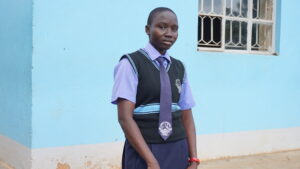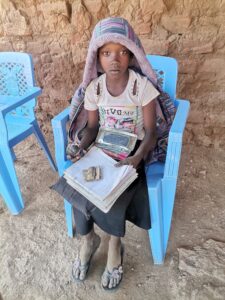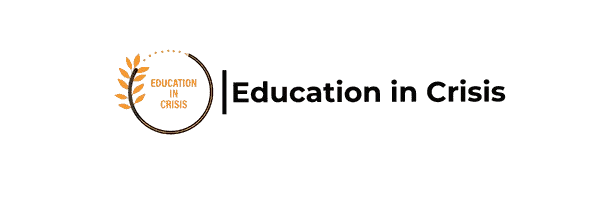Emergencies & Crisis Response
Every child deserves a chance. Be the reason they thrive today.
 DONATE NOW AND SUPPORT OUR MISSION.
DONATE NOW AND SUPPORT OUR MISSION.
Thematic Expertise and Programme
Transforming Emergency Response into a Bridge toward Recovery and Resilience
- Leading Response, Restoring Hope
When crisis strikes, it is children who bear the heaviest burden — their classrooms fall silent, their dreams are paused, and their futures hang in the balance. Education in Crisis (EiC) was born from the urgent need to protect those dreams. We step in where conflict, displacement, and disaster threaten to erase the right to learn — transforming emergency response into a bridge toward lasting recovery and resilience.
Across Sudan, South Sudan, Kenya, Tanzania, and Uganda, EiC’s teams with accumulated years of experiences work on the frontlines of some of the world’s most complex humanitarian emergencies. Our approach to crisis response goes beyond immediate relief; it restores learning, dignity, and protection. Through Emergency Response Framework programming, EiC responds to:
🔴 1. Conflict and Displacement Emergencies
🌪️ 2. Natural Disasters and Climate Shocks
🍞 3. Food and Nutrition Crises
🧒🏾 4. Protection and Gender-Based Violence Emergencies
🦠 5. Health and Epidemic Outbreaks
EiC strives to ensure that even in the most fragile contexts, children and young people can access safe learning spaces, accelerated education, and psychosocial support that nurture both knowledge and hope.
Our response model is (C-lediD-data); Community-led, inclusive, and Data-driven. From rapid needs assessments to mobile learning interventions, EiC responds immediately with its thematic strengths in education, protection, inclusion, and livelihoods, acting swiftly to reconnect children to education while supporting families through cash-based assistance, nutrition programs, temporary shelters, and gender-responsive protection mechanisms. Every EiC intervention integrates protection, gender equality, and conflict sensitivity — ensuring that education in emergencies is not just about access, but about safety, inclusion, and empowerment.
With every classroom rebuilt and every child reached, EiC reaffirms its belief that education is not a privilege reserved for peace — it is a lifeline in crisis. Through partnerships with governments, UN agencies, and local organizations, EiC continues to strengthen systems that help communities rise from emergencies stronger, more united, and more resilient than before.
2. Education in Emergencies (EiE) & Crisis Response
According to data provided by UNHCR, there are currently 82.4 million forcibly displaced people around the world. As of today, there are twice as many displaced people as in 2011, when they totalled just under 40 million. Moreover, children under the age of 18 account for 42% of all displaced people. We’ve reached a moment at which 1% of the world’s population has had to flee their homes due to, conflicts and natural disasters.
In 2001 the United Nations created World Refugee Day to honour refugees and displaced people around the world every 20 June. The event seeks to highlight the rights, needs and dreams of the refugee population and promote empathy and understanding.
In times of crisis, education is a lifeline to children and their families. It can help protect their physical and mental health, allows them to continue to learn and develop, and offers them a sense of normalcy and hope for a better future. Delivering timely, high quality Education in Emergencies (EiE) requires staff with the right skills – our EiE Professional Development Programme (PDP) aims to develop these.
Conflict, climate change, disasters, public health emergencies, and the forced displacement of people within and across borders are affecting a growing number of people all over the world. `In 2021, 235 million people needed humanitarian assistance and protection. Emergencies have a devastating impact on the right to education of millions of people. In 2019, 127 million primary and secondary school-age children and young people living in crisis-affected countries were out of school.
For the most marginalised—learners with disabilities, girls, and those from low-income households, among others—the impact is much greater. Despite this dire situation, education remains one of the most underfunded areas of humanitarian aid, receiving just 2,4 % of total global humanitarian funding.
A generation of children and young people living in emergencies are deprived not only of their human right to quality education, but also of the protection that education provides in these contexts. In emergencies, education may be the only safe space. EiC provides immediate and long-term education solutions for children affected by conflict, displacement, and natural disasters.

EiC’s Key Interventions and commitment to EiE
Our emergency response work is grounded in a child-centered, rights-based and participatory approach that integrates education, protection, nutrition, relief response and psychosocial support as critical life-saving components for displaced, marginalized and crisis-affected populations. We respond rapidly through community-led mechanisms supporting;
- Temporary learning shelters and WASH support in schools,
- Establishing community-based protection committees, working groups and referral mechanisms,
- Conducting rapid PSEA, GBV risk assessments and awareness campaigns,
- Psychosocial support and trauma counselling for survivors,
- Awareness and hygiene campaigns through school clubs and community networks,
- Inclusion of persons with disabilities, refugees, internally displaced persons (IDPs), women, youth and
- Teacher training in alternative and remote learning methodologies.
Regardless of the situation they find themselves in, all children have the right to education. In 2023, therefore, at EiC we began to adapt and develop our Digital Education Framework in Africa to crisis-related contexts by applying a holistic approach aligned with the principles of the INEE (Inter-Agency Network for Education in Emergencies). We are working with local communities and organisations that help us to address other areas that are also necessary for ensuring high-quality learning within a refugee context, including psychosocial support, safe learning spaces and food, nutrition and health care.

Helping out-of-school children catch up on lost education. Globally, there are about 105 million out of school children in emergencies (OOSCiE); this includes children aged 3 until the expected age of completion of upper secondary. About 52% of all OOSCiE live in eight countries alone: Ethiopia, Pakistan, Afghanistan, Sudan, DR Congo, Myanmar, Mali, and Nigeria. These OOSCiE are out of school, either because they never started, or because they dropped out after enrolment. The most marginalized are most at risk, including forcibly displaced children and young people, ex-combatants, girls, and children and youth with disabilities. With each missed school year, there is a greater likelihood that these learners will be unable to return to formal education, resulting in greater risks to their protection. It is estimated that about 24 million learners, from pre-primary to university level, are at risk of not returning to school in 2020 following the education disruption due to COVID-19 (UNESCO, 2020).
What is Accelerated Education?
Accelerated Education (AE) is a flexible, age-appropriate program run in an accelerated time frame, which aims to provide access to education for disadvantaged, over-age, out-of-school children and youth. This may include those who missed out on or had their education interrupted by poverty, marginalization, conflict, and crisis. The goal of Accelerated Education Programmes (AEPs) is to provide learners with equivalent, certified competencies for basic education using effective teaching and learning approaches that match their level of cognitive maturity.
Establishing temporary learning centers in conflict zones. In countries affected by emergencies, children lose their loved ones and homes. They lose access to safe drinking water, health care and food. They lose safety and routine. And, without access to education, they risk losing their futures. Over 470 million children – more than one in six globally – live in areas affected by conflict. Education has been severely disrupted in these conflict zones – by the end of 2024, more than 52 million children in countries affected by conflict are estimated to be out of school. Girls are nearly 2.5 times more likely to be out of school in conflict-affected countries compared to girls in other places.
EiC helps children develop skills to cope with the trauma of crisis, and supply them with learning spaces that are safe, child-friendly and equipped with water and sanitation facilities. Our work builds capacity by training teachers, supplying learning materials and supporting community efforts to reduce the risk of child marriages. At the centre of it, EiC strongly advocates for the right to education for every child and a protective learning environment, forging partnerships at all levels to safeguard learning for every child. EiC monitors and supports the implementation of the Safe Schools Declaration and Guidelines for Protecting Schools and Universities from Military Use during Armed Conflict. The State of the World’s Children 2015 by UNICEF – Reimagine the Future – stated that Technology initiatives must be carefully designed to ensure that these powerful tools will connect with and improve the way teachers teach and students learn in each educational context. They must also be cognizant of the local context – taking into account the infrastructure and capacities required to make technologies work. The full technology ecosystem described below will be most viable in contexts that have reliable electricity, Internet access, teacher training in technology use, and sufficient resources to cover the basics. But programme designers and policymakers working in other contexts should consider which components of the ecosystem will best support their educational objectives.
Technology is only a small part of a successful education transformation. Successful e-learning projects require policy changes, new teaching practices, new education resources and additional training and ongoing support for educators – all of which are where the real educational benefit lies. However, it is fundamental to get the technology part right to enable the desired transformations in teaching and learning. While the current discussion on one-to-one learning suggests that the basis is ‘one device’ for every student, the focus should not be on a single technology device, but rather on how to use multiple technologies to reach the more meaningful goals of improving teaching practices, access to educational resources and, finally, what and how students learn. EiC has developed an innovative e-learning program to address some of the learning barriers children face in achieving literacy and numeracy proficiency, access to, and quality of education in emergency situations. The TutaLearn, a digital learning hub whose mission is to enable continuous access to quality education for children, youth, and teachers especially in conflict affected areas to drive improved learning outcomes through high- quality, portable / distance education to support their entry into other education or opportunity pathways, including formal education. EiC also developing data-driven tool, the Education Crisis Response Dashboard (ECRD) to gather real-time education disruption, learning outcomes data to help policy makers, donors and strategic partners in responding to education in humanitarian contexts.
We cannot do it alone. Together, stronger we can.
Education and learning are not just about books and classrooms; it’s about offering hope, resilience, and the promise of a better future.
Despite the small support provided by EiC and other humanitarian actors, the education needs of children in emergencies far exceeds the assistance that is currently provided.
Greater funding is urgently needed to support the world’s most vulnerable children left behind with lifesaving education.
Let’s stand together to support these children and safeguard their right to education.
Their futures depend on it.
